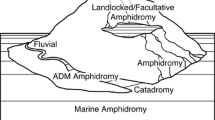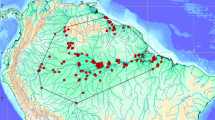Abstract
Diadromy is a term used to describe migrations of fishes between fresh waters and the sea; these migrations are regular, physiologically mediated movements which occur at predictable life history phases in each diadromous species, they involve most members of a species' populations, and they are usually obligatory. Around 250 fish species are regarded as diadromous. A review of the life history strategies amongst families of fishes that include diadromous species provides little support for a suggested scenario for their evolution that involves: (1) evolution of anadromy via amphidromy from fishes of marine origins, and (2) evolution of catadromy through amphidromy from fishes of freshwater origins, even though these scenarios seem intuitively reasonable. The various forms of diadromy appear to have had multiple independent origins amongst diverse fish groups. There is increasing confidence that behavioural characteristics of animals are heuristic in gener ating and interpreting phylogenies. However, examination of fishes shows wide variability of diadromous life histories within closely related families and genera, within species, and there is even ontogenetic variation in patterns of behaviour by individual fish. In addition, there is multiple loss of diadromy in many diadromous fish species in which the life history becomes restricted to fresh waters. This variation suggests that diadromy is a behavioural character of dubious worth in determining phylogenetic relationships. Moreover, it appears to have been an ancestral condition in some fish families, such as Anguillidae, Salmonidae, Galaxiidae, Osmeridae, and others, and perhaps in the whole salmonoid/osmeroid/galaxioid complex of families. This, too, makes diadromy of dubious worth in phylogenetic analysis
Similar content being viewed by others
References
Arthington, A.H. (1992) Diets and trophic guild structure of freshwater fishes in Brisbane streams. Proc. R. Soc. Queensland 102, 31-47.
Balon, E.K. (1975) Reproductive guilds of fishes: a proposal and definition. J. Fish. Res. Bd Can. 32, 821-864.
Balon, E.K. (1981) Additions and amendments to the classification of reproduction styles in fishes. Env. Biol. Fishes 6, 377-389.
Balon, E.K. and Bruton, M.N. (1994) Fishes of the Tatinga River, Comoros, with comments on freshwater amphidromy in the goby Sicyopterus lagocephalus. Ichthyol. Explor. Freshwat. 5, 25-40.
Begle, D.P. (1991) Relationships of the osmeroid fishes and the use of reductive characters in phylogenetic analysis. Syst. Zool. 40, 33-53.
Burgner, R.L. (1991) Life history of sockeye salmon (Oncorhynchus nerka). In Groot, C. and Margolis, L., eds. Pacific Salmon Life Histories. Vancouver: UBC Press, pp. 1-117.
Dobson, F.S. (1985) The use of phylogeny in behaviour and ecology. Evolution 39, 1384-1388.
Fink, W.L. (1984) Basal euteleosts: relationships. Am. Soc. Ichthyol. Herpetol. Spec. Publ. 1, 202-206.
Fink, W.L. and Weitzman, S.H. (1982) Relationships of stomiiform fishes (Teleostei), with a description of Diplophos. Bull. Mus. Comp. Zool. Harv. Univ. 150, 31-93.
Fontaine, M. (1975) Physiological mechanisms in the migrations of marine and amphihaline fish. Adv. Mar. Biol. 13, 241-335.
Foster, N.R. (1969) Factors in the origins of fish migrations. Underwater Nat. 6, 27-31, 48.
Gross, M.R. (1987) The evolution of diadromy in fishes. Am. Fish. Soc. Symp. 1, 14-25.
Healey, M.C. (1991) Life history of chinook salmon (Oncorhynchus tschawytscha). In Groot, C. and Margolis, L, eds. Pacific Salmon Life Histories. Vancouver: UBC Press, pp. 311-393.
Heard, W.R. (1991) Life history of pink salmon (Oncorhynchus gorbuscha). In Groot, C. and Margolis, L., eds. Pacific Salmon Life Histories. Vancouver: UBC Press, pp. 119-230.
Helle, J.H. (1970) Biological characteristics of intertidal and fresh-water spawning pink salmon at Olsen Creek, Prince William Sound, Alaska, 1962-63. U.S. Dep. Int. Fish Wildl. Serv. Spec. Sci. Rep. No. 602. 1-19.
Hennig, W. (1966) Phylogenetic Systematics. Urbana: University of Illinois. 263 pp.
Hoar, W.S. (1976) Smolt transformation: evolution, behaviour and physiology. J. Fish. Res. Bd Can. 33, 1233-1252.
Hughes, J.M., Bunn, S.E., Kingston, D.M. and Hurwood, D.A. (1995) Genetic differentiation and dispersal among populations of Paratya australiensis (Atyidae) in rainforest streams in southeast Queensland, Australia. J. North Am. Benthol. Soc. 14, 158-173.
Johnson, G.D. and Patterson, C. (1996) Relationships of lower euteleostean fishes. In Stiassny, M.J.L., Parenti, L.R. and Johnson, G.D., eds. Interrelationships of Fishes, 2nd edn. New York: Academic Press, pp 251-332.
Kakimoto, H. and Hayashi, K.I. (1995) Experiments on fishways for freshwater amphidromous shrimps. Nippon Suisan Gakkaishi 61, 171-178.
Kato, F. (1991) Life histories of masu and amago salmon (Oncorhynchus masou and Oncorhynchus rhodurus). In Groot, C. and Margolis, L., eds. Pacific Salmon Life Histories. Vancouver: UBC Press, pp. 447-520.
Kinzie, R.A. (1991) Hawaiian freshwater ichthyofauna. In New Directions in Research, Management and Conservation of Hawaiian Freshwater Stream Ecosystems: Proceedings of the 1990 Symposium on Freshwater Stream Biology and Fisheries Management. Honolulu: Division of Aquatic Resources, Department of Land and Natural Resources, pp. 18-39.
McAllister, D.E. (1963) A revision of the smelt family Osmeridae. Nat. Mus. Can. Bull. 191, 1-53.
McDowall, R.M. (1968) The application of the terms anadromous and catadromous to the southern hemisphere salmonoid fishes. Copeia 1968, 176-178.
McDowall, R.M. (1969) Relationships of galaxioid fishes, with a further discussion of salmoniform classification. Copeia 1969, 796-824.
McDowall, R.M. (1979) Fishes of the family Retropinnidae (Pisces: Salmoniformes)-a taxonomic revision and synopsis. J. R. Soc. N.Z. 9, 85-121.
McDowall, R.M. (1988) Diadromy in Fishes: Migrations between Freshwater and Marine Environments. London: Croom Helm. 308 pp.
McDowall, R.M. (1990) New Zealand Freshwater Fishes: a Natural History and Guide. Auckland: Heinemann Reed. 553 pp.
McDowall, R.M. (1992) Diadromy: origins and definitions of terminology. Copeia 1992, 248-251.
McDowall, R.M. (1993) A recent marine ancestry for diadromous fishes? Sometimes yes, but mostly no. Env. Biol. Fishes 37, 329-335.
McDowall, R.M. (1994) Distinctive form and colouration of juvenile torrentfish Cheimarrichthys fosteri (Pisces: Pinguipedidae). N.Z. J. Mar. Freshwat. Res. 28, 385-390.
McDowall, R.M. (1997) Is there such a thing as amphidromy? Micronesica 30, 3-14.
McLennan, D.A. (1991) Integrating phylogeny and experimental ethology: from pattern to process. Evolution 45, 1773-1789.
McLennan, D.A. (1994) A phylogenetic approach to the evolution of fish behaviour. Rev. Fish Biol. Fish. 4, 430-460.
McLennan, D.A., Brooks, D.R. and McPhail, J.D. (1988) The benefits of communication between comparative ethology and phylogenetic systematics: a case study using gasterosteid fishes. Can. J. Zool. 66, 2177-2190.
Mayden, R.L. and Wiley, E.O. (1992) The fundamentals of phylogenetic systematics. In Mayden, R.L., ed. Systematics, Historical Ecology and North American Freshwater Fishes. Stanford: Stanford University Press, pp. 114-185.
Mitchell, C.P. (1994) Whitebait spawning ground management. Department of Conservation Science and Research Series (New Zealand) 69, 1-23.
Morrow, J.E. (1980) The Freshwater Fishes of Alaska. Anchorage: Alaska Northwest Publishing. 248 pp.
Myers, G.S. (1949) Usage of anadromous, catadromous and allied terms for migratory fishes. Copeia 1949, 89-97.
Nelson, J.S. (1994) Fishes of the World, 3rd edn. New York: Wiley. 600 pp.
Nordeng, H. (1983) Solution to the 'char problem' based on Arctic char (Salvelinus alpinus) in Norway. J. Fish. Res. Bd Can. 40, 1372-1387.
Northcote, T.G. (1967) The relation of movements and migrations to production in freshwater fish. In Gerking, S.D., ed. The Biological Basis of Freshwater Fish Production. New York: Wiley, pp. 315-344.
Northcote, T.G. (1992) Migration and residency in stream salmonids-some ecological considerations and evolutionary consequences. Nord. J. Freshwat. Res. 67, 5-17.
Northcote, T.G. and Ward, F.J. (1985) Lake resident and migratory smelt Retropinna retropinna (Richardson), of the lower Waikato River system. N.Z. J. Mar. Freshwat. Res. 17, 113-129.
Parenti, L.R. and Maciolek, J.A. (1993) New sicydiine gobies from Ponape and Palau, Micronesia, with comments on the systematics of the subfamily Sicydiinae (Teleostei: Gobiidae). Bull. Mar. Sci. 53, 945-972.
Paterson, A.M., Wallis, G.P. and Gray, R.D. (1995) Penguins, petrels and parsimony: does cladistic analysis of behaviour reflect seabird phylogeny. Evolution 49, 974-989.
de Queiroz, A. and Wimberger, P.H. (1993) The usefulness of behaviour for phylogeny estimations: levels of homoplasy in behavioural and morphological characteristics. Evolution 47, 46-60.
Quinn, T.P., Hendry, A.P. and Wetzle, L.A. (1995) The influence of life history trade-offs and the size of incubation gravels on egg size variation in sockeye salmon (Oncorhynchus nerka). Oikos 74, 425-438.
Radtke, R.L. and Kinzie, R.A. (1991) Hawaiian amphidromous gobies: perspectives on recruitment processes and life history events. In New Directions in Research, Management and Conservation of Hawaiian Freshwater Stream Ecosystems: Proceedings of the 1990 Symposium on Freshwater Stream Biology and Fisheries Management. Honolulu: Division of Aquatic Resources, Department of Land and Natural Resources, pp. 125-141.
Regan, C.T. (1911) The Freshwater Fishes of the British Isles. London: Methuen. 287 pp.
Resh, V.H., Barnes, J.R. and Craig, D.A. (1990) Distribution and ecology of benthic macroinvertebrates in the Opunoho River catchment, Moorea, French Polynesia. Ann. Limnol. 26, 195-214.
Rosen, D.E. (1974) Phylogeny and zoogeography of salmoniform fishes and relationships of Lepidogalaxias salamandroides. Bull. Am. Mus. Nat. Hist. 153, 265-326.
Rounsefell, G.A. (1958) Anadromy in North American Salmonidae. Fish Bull. U.S. Fish Wildl. Serv. 62, 171-185.
Salo, E.O. (1991) Life history of chum salmon (Oncorhynchus keta). In Groot, C. and Margolis, L., eds. Pacific Salmon Life Histories. Vancouver: UBC Press, pp. 231-309.
Schneider, D.W. and Lyons, J. (1993) Dynamics of upstream migration in two species of tropical freshwater snails. J. North Am. Benthol. Soc. 12, 3-16.
Scott, W.B. and Crossman, E.J. (1973) Freshwater fishes of Canada. Bull. Fish. Res. Bd Can. 184, 1-996.
Stearley, R.L. (1992) Historical ecology of Salmoninae, with special reference to Oncorhynchus. In Mayden, R.L., ed. Systematics, Historical Ecology and North American Freshwater Fishes. Stanford: Stanford University Press, pp. 622-658.
Svenning, M.A., Smith-Nilsen, A. and Jobling, M. (1992) Sea water migration of Arctic char (Salvelinus alpinus L.)-correlations between freshwater growth and seaward migration based on back-calculations from otoliths. Nord. J. Freshwat. Res. 67, 18-26.
Taylor, M. (1996) How native fish spawn on land. Water and Atmosphere 4(3), 23-25.
Tchernavin, V. (1939) The origin of salmon-is its ancestry marine or fresh water? Salm. Trout Mag. 95, 120-140.
Thorpe, J.E. (1982) Migration in salmonids with special reference to juvenile movements in fresh water. In Brannon, E.S. and Salo, E.O., eds. Proceedings of the Salmon and Trout Migratory Behaviour Symposium. Seattle: School of Fisheries, University of Washington, pp. 86-97.
Thorpe, J.E. (1987) Smolting versus residency: development conflicts in salmonids. Am. Fish. Soc. Symp. 1, 224-252.
Tinbergen, N. (1953) Social Behaviour in Animals: with Special Reference to Vertebrates. London: Methuen. 228 pp.
Tinbergen, N. (1959) Behaviour, systematics and natural selection. Ibis 101, 318-330.
Tinbergen, N. (1964) On aims and methods of ethology. Zeit. Tierpsych. 20, 410-433.
Wiley, E.O. (1981) Phylogenetics: the Theory and Practice of Phylogenetic Systematics. New York: Wiley. 419 pp.
Williams, W.D. and Smith, M.J. (1979) A taxonomic revision of the Australian species of Paratya (Crustacea: Atyidae). Aust. J. Mar. Freshwat. Res. 30, 815-832.
Wootton, R.J. (1976) The Biology of the Sticklebacks. London: Academic Press. 387 pp.
Wootton, R.J. (1984) A Functional Biology of Sticklebacks. London: Croom Helm. 265 pp.
Author information
Authors and Affiliations
Rights and permissions
About this article
Cite this article
McDowall, R. The evolution of diadromy in fishes (revisited) and its place in phylogenetic analysis. Reviews in Fish Biology and Fisheries 7, 443–462 (1997). https://doi.org/10.1023/A:1018404331601
Issue Date:
DOI: https://doi.org/10.1023/A:1018404331601




